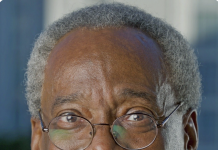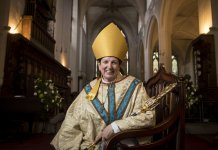Monday 7 & Tuesday 8 November saw two moving services as the Shrine of St Chad was consecrated and reinstated at Lichfield. 484 years after the original shrine was destroyed, a new Altar Shrine has been built and a relic of St Chad translated from St Chad’s Roman Catholic Cathedral, Birmingham.
In a historic moment and deeply poignant ecumenical service, Archbishop Bernard Longley and Bishop Michael Ipgrave gave a heartfelt address.
The address can be viewed here:
The transcript follows:
Archbishop Bernard Longley:
It is with a great sense of joy and historical purpose that we come together for this ecumenical celebration of Evening Prayer in Lichfield Cathedral today. Under our shared patronage of St Chad, the bonds of faith and affection that exist between our two dioceses and their respective cathedrals are deepened and set on a new trajectory.
As Roman Catholic Archbishop, linked through communion with the See of Rome with the ancient and enduring Christian community founded by St Chad, it is a privilege and a joy to enter into this moment of prayer and the sharing of gifts at the side of my colleague and friend, Bishop Michael Ipgrave, the successor of St Chad in the See of Lichfield.
In his Ecclesiastical History of the English People the Venerable Bede recounts the story of St Chad’s appointment by Archbishop Theodore of Canterbury to oversee the spiritual care of the people of Mercia. According to his custom, St Chad preferred to walk when evangelizing and going about his pastoral duties.
But knowing the extent of the territory Chad had to cover, Archbishop Theodore proposed that he should travel on horseback. When Chad showed signs of hesitation, Bede tells us that the archbishop lifted Chad onto a horse with his own hands, since he knew him to be a man of simplicity, holiness, and obedience, to enable him to travel more freely and effectively. (St Chad, must have been quite light, too!)
Well, you will be pleased to know that the relic of St Chad, which has been brought today on behalf of the Roman Catholic community and accompanied by the Canons of the Metropolitan Chapter of St Chad’s Cathedral in Birmingham, has returned to Lichfield not with hesitation, but with alacrity and gratitude. We recognise the impact of his holiness of life and the affection that St Chad inspires within both our traditions, knowing that his relic will become a focus for prayer in this beautiful restored shrine, inspired by his witness and strengthened by his prayers interceding for our two diocesan families.
Today’s celebration is the fruit of a lengthy conversation and it reflects the ecumenical journey that we have travelled together in growing respect and understanding for each other’s history and traditions. Our experience of the past must always help us to understand our present and to shape what lies ahead of us.
You will know that the veneration of relics and their enclosure in the altars of Catholic churches comes from the earliest days of the Church, as Christians sought to recall and celebrate the example of faith of the early martyrs. The tradition of venerating the relics of saints encourages us to reflect on their lives as signposts of faith, always leading us toward a deeper encounter with Our Lord through the experience of His love and mercy. As St Chad bears witness, each saint offers a unique insight into a life lived in virtue and in faithfulness to God’s grace. The saints testify to the opening words of today’s reading from Ecclesiasticus, urging us to perform our tasks with humility so that we will be loved by those whom God accepts.
Perhaps St Chad’s own preference for traveling on foot teaches us something else today. Walking is the way of the pilgrim and it gave St Chad time to consider and to reflect on what he saw as he met people along the way. (He must also have been very familiar with the strong Staffordshire wind which we encountered today as we walked from St Chad’s Well towards the Cathedral!) Perhaps St Chad recalled St Luke’s account of the road to Emmaus as the risen Jesus walked unrecognised with the two disciples before they saw him in the breaking of bread. Such journeys allow the time for deeper conversations, listening to one another and growing in friendship through accompaniment.
The veneration of relics has been a cause of division in our shared history – but today is a moment that draws us together as we seek to reflect on St Chad’s life. In this fragment of bone which has been cherished through the centuries in this Cathedral and across the Midlands, we witness a final homecoming, ensuring that Lichfield Cathedral will continue to be a place of encounter and friendship between Anglicans and Roman Catholics and for all those who are baptised in Christ.
I pray that today will enable us to grow our life together as disciples of Christ, supported and sustained in this shared endeavour through the prayers of St Chad. May this relic be a symbol of our friendship and the unity in faith in Christ which we already enjoy – and may it always foster the fullness of unity for which Jesus prayed: that we might all be one.
Bishop Michael Ipgrave:
I want to express my heartfelt gratitude to Archbishop Bernard and to the Archdiocese of Birmingham for this wonderful gift of a relic of the mortal remains of our first bishop. It is a great sign of the friendship between our two communities, as together we seek to follow Christ in the footsteps of St Chad, and that is a friendship which also links us with people of other Christian traditions today; this is a heartfelt celebration of ecumenical trust and partnership.
The language of relics does not come naturally to many Anglicans, and veneration of them does not usually form part of our spiritual practice; but we do use the language and practice of memory and remembering, which is particularly poignant for us around this time of year. It was just over five years ago that the late and much-loved Dean of St Chad’s Cathedral, Fr Gerry Breen (who was also an ecumenical canon of this Cathedral) spoke to a large pilgrimage marking the 500th anniversary of the Reformation. Fr Gerry talked about the importance of remembering those whom we love and honour, and how natural it is for us to have – for example – a photograph of a loved one, or one of their precious belongings, as a keepsake to aid memory.
How much more, then, to treasure a part of their mortal remains, as we are doing today. And our memories on an occasion like this have to be mixed – we call to mind with gladness and thanksgiving Chad, saint of the universal and undivided church of Jesus Christ, and we call to mind in shame and penitence the bitter divisions which have separated us from one another and so grievously wounded the credibility of the message which Chad proclaimed to us all. Today, 8th November, as we recall the saints and martyrs on all sides of the Reformation era, we pray fervently for the healing of Christ’s shattered church.
The memory we celebrate today not only causes us to look backwards; it also directs us to the present and points us to the future. The saint whose mortal remains we honour today is not just any old body; we are re-placing here in Lichfield one who was first buried and venerated here because he was the first to bring the gospel of Jesus Christ to this part of England. To the divided, war-torn and violent pagan kingdom of Mercia, Chad came from the bitter enemy, Northumbria. He came armed with peace and humility, a loving concern for the well-being of every soul, and an unshakeable confidence in the hope that the gospel of Jesus Christ begins. For three brief years he walked through the farmsteads, villages and settlements of Mercia, meeting and greeting all he met in the name of the Lord and sharing with them the good news that sets us free.
In our present, in our own time, it seems that we are really back at the beginning where Chad was. Our society, like that of seventh century England, is fearful, divided and sometimes despairing. Our task is Chad’s task all over again: to evangelise our twenty-first century Mercia with the gospel of peace and hope, of forgiveness and healing for men, women and children in their brokenness and lostness, of a common good in which all can flourish and grow together. It is my prayer today that all who visit this shrine, to celebrate the memory of St Chad, will be inspired to share again his zeal in bringing the gospel to the West Midlands.
Our remembering of Chad, and particularly our grateful reception of this precious relic of his mortal body, must also point us to the future. For us Christians, life is lived under the horizon of a hope which has been opened up to us in the raising of Jesus on the third day, and which will be fulfilled in us when God raises us in glory with Christ. Last Sunday, the 32nd Sunday in Ordinary Time (which the Church of England also chooses to call the 3rd Sunday before Advent) the eucharistic readings in our Common Lectionary gave us that wonderful passage in Luke 20 where the Lord proclaims the reality of God’s new life against the cavilling of the Sadducees. In a striking phrase found only in Luke, Jesus declares that in the age to come we will be ‘children of the resurrection.’ It is that promise to which we cling in honouring the mortal remains of our brother Chad.
Those mortal remains are not just bits of bone or flesh – not Chad’s, nor the remains of any whom we have loved. They are the relics and traces of the mortal bodies in and through which there once lived the sons and daughters of God, the brothers and sisters of Christ, and with Christ those bodies will be raised one day to fulness of life. Sown in mortality, corruptible, they will be raised in immortality, glorious. It is that sure and firm hope of resurrection which we proclaim today.
So it is right that a part of Chad’s mortal remains should be brought back here to the place where they once were laid. It is good that today we join together not only as Anglicans and Roman Catholics but as brothers and sisters of other churches too. We all have much to learn from one another, and I have been learning much recently from the Moravian tradition in particular. It is from the early Moravians that we have the English phrase ‘God’s acre’ for a graveyard, for they saw it as a field in which the dead bodies of the saints would be planted like seeds until the glorious harvest of the resurrection. We are not in a graveyard, but the same principle applies: the resting of mortal remains here points forwards to the coming kingdom of Christ. The founder of the Moravians, Count Nikolaus Zinzendorf, once said: ‘To lie in the tomb is a liturgical act.’ As we share this liturgy together as Christian friends, may God’s grace remake us to go out in humility and hope proclaiming the kingdom, as Chad did 1350 years ago.










